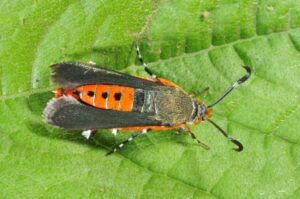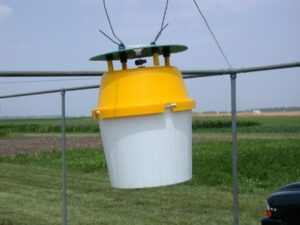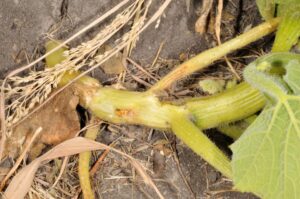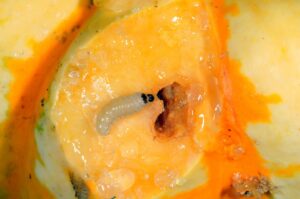For some, we may often forget about the pesky squash vine borer until it’s too late. This pest of cucurbit crops tends to be sporadic in our region; you are either battling it every year or it hardly makes an appearance. And, unfortunately, our urban farmers tend to get hammered. While it is not so much of a problem on large farms, with many acres of cucurbits, small farms and organic growers tend to be the most impacted by this pest. The squash vine borer is a member of the clear-winged moths, a unique group of moths that are active during the daytime (Figure 1).

Figure 1. An adult clear wing moth, the larvae of which is the Squash Vine borer. (Photo by John Obermeyer.)
They are very beautiful with their bright colored orange tufts on their legs, but can be devastating. The insect overwinters as a late instar larvae or pupa in the soil. In our region, as the soil warms, they complete their development and adults emerge around mid-June. There are multiple ways to monitor for this pest, but currently I have bucket traps available for anyone who would like to host one and report moth catches to me. The traps are equipped with a pheromone lure that smells like the females, and pulls the male moths into the bucket. We place a strip in the base of the bucket trap that has been impregnated with insecticide, and will therefore kill the adult males that make their way in (Figure 2).

Figure 2. Bucket traps, such as this one, are available to catch the adult Squash Vine Borer. (Photo by John Obermeyer.)
Trapping adult male moths can help us better understand their biology, peak emergence, and timing of management strategies. Within three days of adult emergence, the females are ready to begin laying eggs. They lay eggs singly on the stem of the plant. The eggs are small, reddish-brown and each individual female can travel up to one mile and lay 150-200 eggs in a lifetime. The eggs will hatch in 6-11 days after being laid on the plant. The larvae that hatch then burrow into the stem, where they remain, protected and feeding on plant tissues. Their feeding disrupts water and nutrient transport in the plant, resulting in the plant wilting and ultimately dying if the main stem is attacked. The larvae remain in the plant, feeding for 24-27 days, before dropping into the soil to pupate. SVB damage can be distinguished from other squash pests by the identification of the entry site of the larva into the stem and the presence of frass (insect poop) that looks like sawdust (Figure 3) In northern states (Wisconsin and Minnesota) there is only one generation per year. Here, in Indiana, we may experience two, with the second larval feeding damage occurring in Sept-Oct and often happening on ripening fruits (Figure 4). Cooperation with trapping will help us better understand these dynamics.

Figure 3. Entry site for the larvae of the Squash Vine Borer on a cucurbit stem. (Photo by John Obermeyer.)
Management Strategies
Selecting resistant varieties is one method to reduce the damage. In general, this pest prefers varieties that have soft, wide stems. Selecting varieties that have narrow and more woody stems deters the pest. Selecting vine-type varieties over bush-type is beneficial because the vine-type can root at their nodes and lessen the damage to the overall plant. SVB are least attracted to varieties of Cucurbita moschata (Dickinson pumpkin, butternut) and C. argyrosperma (Green striped cushaw) compared to C. maxima and C. pepo varieties.
Crop rotation is an important preventative measure. This is most effective if you have large acreage and can rotate the location of susceptible cucurbits at least one mile from the previous year. For our small farmers and urban farmers, this may not be feasible. In that situation, growing cucurbits on a every other year rotation cycle is best.
Sanitation is another preventative measure to take. Do not leave wilting and infested plants in the garden or on the compost bin next to the garden. The pests can survive and reinfest the following year. Burning the crop residue or disking/tilling at a depth of at least 5 cm can destroy the overwintering larvae/pupae.
Using row covers to prevent the adults from reaching the plants is effective on small cropping areas. The covers can be installed when the crop is seeded/transplanted or can be placed over the crop when adults are caught in pheromone traps. The cover needs to be installed securely to prevent the females from reaching the vines and ovipositing on the plant. If you have not rotated your crops, covers may actually be detrimental because you could trap emerging adults underneath them. Pollination is also important in this crop, so removing the covers when trap catches are no longer happening or when you have 50% of plants blooming is necessary so you do not hinder pollination.
Pesticide applications can be effective on both conventional and organic farms. The important thing to consider is the exposure of pollinators to residues when applications for SVB co-occur with crop flowering. Pyrethroids remain an effective class of insecticides to manage this pest. For organic growers, formulations of Spinosad and Bacillus thuringiensis are also effective. The most important factor with pesticide control is making applications close to egg hatch so that larvae ingest the toxins prior to burrowing into the stem, where injections of the product would be needed to get control. As always, consult the Midwest Vegetable Production Guide (ID-56) found here when selecting a pesticide and be sure to check the label.
If you want to host a trap on your farm, call me at (765) 494-6167 or email lingwell@purdue.edu.
